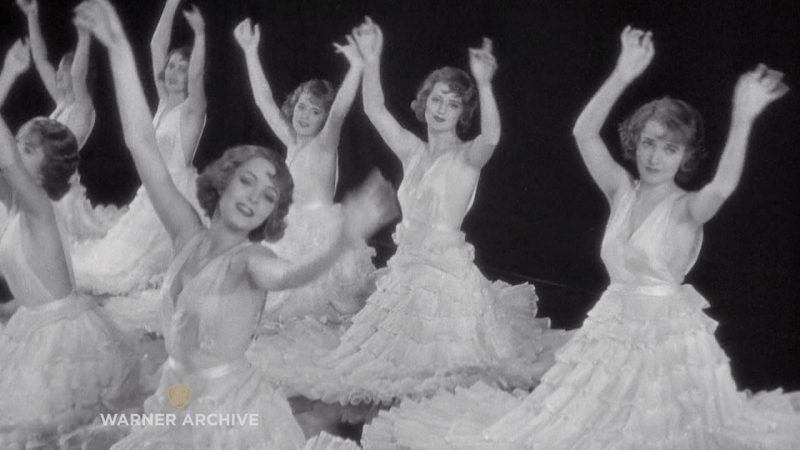Dames is not a great film but easily attains classic status because of a trio of remarkable fantasy sequences shot by gifted choreographer Busby Berkeley.
Much of this slight 1934 musical comedy is a backstage copycat story of little significance. The enduring legacy is found in the last 34 minutes – in back-to-back-to-back musical numbers that are visually stunning and musically witty.
Dames Features Warners’ Holy Trinity of Dick Powell, Ruby Keeler and Joan Blondell
Dames is the cinematic poster child for the Hollywood studio system. Emboldened by the wild success of 42nd Street and Golddiggers of 1933, Warner Bros. set out to make a series of escapist musicals in the midst of the Great Depression. Most were formulaic “the show must go on” tales featuring leads Dick Powell, Ruby Keeler, and Joan Blondell, plus supporting contract players including Guy Kibbee, Aline MacMahon, Hugh Herbert, and others.
Warners studio director Ray Enright shepherded the production written by future director Delmer Daves.
Real Star of the Film is Choreographer Busby Berkeley
But the real credit for Dames’ status as a significant film belongs to choreographer Busby Berkeley, who directed the three key production numbers. The former field artillery lieutenant incorporated a highly-developed sense of symmetry and design developed from military marching exercises and parades he helped create during World War I.
Dames’ storyline is ridiculous, but that’s a given in these films. As in the Astaire-Rogers musicals at RKO, no one really cares about the machinations of how the principals get to the Big Night when The Show Goes On.
But for the purposes of this review, here’s a quick sketch:
Ditsy Hugh Herbert in Vintage Form as Wacky Mogul
Clueless, eccentric multi-millionaire Ezra Ounce is an insufferable moralist. He offers $10 million of his vast fortune to relatives if they can prove they’re morally worthy.
But cousin Mathilda Hemingway (Zasu Pitts) and her husband Horace (the ever-befuddled Guy Kibbee) are worried cousins Ezra might learn of the romance between their daughter Barbara (Ruby Keeler) and her “13th” (i.e., very distant) cousin, Jimmy Higgens (Dick Powell). Jimmy is the family’s black sheep because he’s a songwriter and playwright – exactly the kind of theater riff-raff scorned by high-minded, teetotalling Uncle Ezra.
Joan Blondell Steals Picture
Blondell, who married Powell in real life in 1936, plays Mabel, a cynical chorine who keeps turning up in Horace’s bed, eventually blackmailing him into backing Jimmy’s new Broadway show.
Blondell, at the peak of her sexual allure, steals every scene she’s in. As usual, Keeler’s character, the adorably sweet and spunky girl-next-door virgin, is Blondell’s polar opposite. And Dick Powell’s Jimmy Higgens is exactly the kind of go-getting juvenile lead the actor fled from playing a few years later. (In fact, Powell finagled the lead in the great 1944 noir Murder, My Sweet specifically to escape the kind of typecasting he faced in Dames and the other Warners musicals.)
The silly, amusing stew of a story goes on for 57 minutes before Berkeley takes over for director Enright and gets down to business.
The Girl at the Ironing Board
The first number, by the great songwriting team of Harry Warren and Al Dubin, features Joan Blondell — who talk-sings it because she can’t carry a tune. Doesn’t matter, because the elaborate sequence is fun, clever and visually striking. Blondell plays a lonely laundress who serenades (and eventually dances with) men’s long johns, t-shirts and other unmentionables as she pins them on clotheslines. It’s a song about longing and while she can’t sing, Blondell carries the sequence on personality alone.
As with all three songs, Berkeley “opens up” the number so that it’s performed in a vast expanse much larger than the theater stage on which it’s supposed to be staged. The Girl at the Ironing Board cues us you shouldn’t expect logic from Busby Berkeley.
I Only Have Eyes For You
This Warren-Dubin composition was written specifically for Dames – and became an instant standard. Ruby Keeler and Dick Powell begin the croon-fest at a theater box office, stroll through New York City and eventually take a long, surreal subway ride incorporating an elaborate fantasy sequence in which Keeler’s face is celebrated and recreated in ways that should be seen, not described.
Dames
The title song is the film’s piece de resistance, a remarkable sequence, as much fun to watch as anything Berkeley ever put on film. Dick Powell plays a hard-driving Broadway producer interviewing beautiful chorus girls for a show. There are in-jokes, such as when he tells his secretary via intercom he doesn’t have time for calls from “Mr. George Hershwin” and “Mr. Earl Farrell.” It’s a wink to us that the sly references are really to Gershwin and 1930s stage impresario Earl Carroll.
The sequence is the sexiest (and sometimes strangest) of the three, depicting beauties sleeping together in twos, taking bubble baths and engaging in Berkeley’s famous human geometric designs shot from overhead.
Dames is a fun, frothy light musical comedy that buoyed spirits at the depths of the Great Depression. That it can still amaze and delight us more than 75 years later is a testament to its creativity and sense of fun and adventure.


Be First to Comment